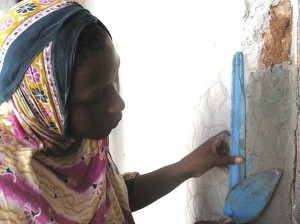Compiled by Donovan Mc Grath
2009 marks the third year of Jakaya Kikwete’s presidency in Tanzania. Elections are scheduled for October 2010 and Kikwete, whose popularity is not as high as it was a year ago, is widely expected to achieve a second and final five-year term of office. However, such optimism is not without its challenges. There is an impending Bill that approves the amalgamation of several rival parties, strengthening the opposition. Old allies, like former-prime minister Edward Lowassa and businessman Rostam Aziz, may also challenge the president. Lowassa, who was forced to resign after being implicated in a corruption case of which he claims innocence, is currently thought to be considering presidential ambitions. It is Kikwete’s ‘moves against high-level graft in government and the ruling CCM’ that has earned him rivals among former allies – Extract from THE AFRICA REPORT (No 14. Dec – 08 Jan 09): ‘The CCM will want to maintain the tradition of allowing the sitting president to serve a second term, but powerful cliques are fighting Kikwete’s determination to reinstate a leadership code of conduct that will forbid business people from holding office and running their private companies concurrently. If this pressure were to threaten his hold on power, the president could yet go after more high-profile politicians and bureaucrats accused of corruption.
‘Another area of pressure on Kikwete comes from Zanzibar’s main opposition party, the [Civic United Front], which hopes to force Zanzibar’s President Amani Abeid Karume and conservative ruling party members into a power-sharing government before the 2010 elections.
Karume reneged on an earlier deal to do so but now says a coalition could follow the next elections, after he steps down.’
Under the headline: ‘Africa’s hungry tribe’ (OBSERVER MONTHLY Dec 08), freelance journalist Alex Renton expresses the plight of the Maasai of northern Tanzania who are experiencing increasing hunger due to high-prices of staple food. Focusing on a Maasai family living close to Oldonyo Lengai, ‘God’s Mountain’, near Engaresero village, Arusha, the reporter explains how they have resorted to selling family heirlooms in order to survive.
Extracts: ‘…[B]eaded bracelets, anklets, necklaces and chokers in the white, blue and yellow of the Kisongo clan. Some were studded with discs of tin or silver. One Maasai woman was selling her inheritance: wedding gifts, pieces from her mother. All were for sale to the tourists…
She had to sell something, or the family wouldn’t eat that night… There were no animals healthy enough to sell, so to put food in their children’s bellies they had to sell jewellery or beg or borrow money.
‘The principal problem is the global price of food staples – driven up over the past couple of years by the international oil price and the demand for biofuels.’
…A 25kg container of maize grains, enough to feed a family of five for a week, costs up to Shs 10,000 (£5). That may not sound much – but it is nearly double what it was in January.
‘…The biggest problems, though, lie with the volcano, Oldonyo Lengai… When it exploded at the beginning of the year the displacement of people fleeing it also disrupted the food supply.’ – Thanks to Roy Galbraith for sending this – Editor.
Over 80% of the Tanzanian population is employed in the agricultural sector. Tanzania has approximately 44m hectares of fertile land, of which only 10.2m hectares at present is being cultivated. Therefore, it comes as no surprise that President Kikwete promises to invest heavily in agriculture. However, there is a major drawback as THE AFRICA REPORT (Dec 08-Jan 09) reported. Under the headline: ‘Roadblocks to Tanzania’s green revolution’, the reporters highlighted the difficulties faced by foreign companies who wish to invest in the country.
Extract: ‘Tanzania’s sugar industry […] has tripled following the privatisation of four government-owned producers in 1998, but in the last ten years there has been no new foreign investment in the sector. “I imagine that [the lack of investment] is because they [foreign investors] have not been able to find the land to set up a new project,” says Ashwin Rana, general manager of Kagera Sugar and chairman of the Tanzanian Sugar Producers’ Board. One producer, Kilombero Sugar Company, owned by South Africa’s Illovo Sugar, has been waiting to expand its production on a plot of 2,000 hectares to which it has been legally entitled since it bought its plantation in Morogoro ten years ago. There are villagers on the land and [the] government has been slow to relocate them or find a replacement plot. Illovo lost interest and in 2007 took the $200m it had earmarked for Tanzania and invested it in sugar plantations in Mali and Zambia.’
The lives of Albinos in East Africa, reports the ECONOMIST (17 Jan) are at risk from a ‘horrendous trade’. Tanzania’s Head of Police, in Dar es Salaam, distributed ‘free mobile phones to several hundred locals with albinism.’ Extract: ‘Each phone comes with a “hot line” to the police. Albinos text in their location if they suspect they are being tracked by gangsters determined to kill them and harvest their body parts. ‘According to the Tanzanian Albino Society, at least 35 albinos were murdered in Tanzania last year to supply witch doctors with limbs, organs and hair for their potions.’ This is not solely a Tanzanian problem as the killing of albinos has spread to Kenya, Uganda and Burundi. Thank you Simon Hardwick for this item – Editor
The WEST AUSTRALIAN (2 Dec 08), under the headline: ‘100 years ago: Antediluvian Monsters’, published a short article about an important archaeological discovery made in Tanganyika during the early period of German colonial rule: ‘The German Government is sending an expedition to investigate the remains of gigantic antediluvian animals discovered by Professor Fraas in the southern portion of German East Africa. The bones of the hind leg of one animal are 11½ feet long, while the spine is a third longer than that of any animal yet discovered.’ Thank you Douglas Gledhill for sending this item – Editor
‘Game hunting in Tanzania has over the years become a well-established industry and an important source of income for the government,’ writes Mike Mande for the EAST AFRICAN (19-25 January). There are 54 licensed hunting companies operating in the 158 hunting blocks located in the game reserves across 42 districts. This is an increase of the 1988 accounts that stated there were only 21 hunting firms and 128 hunting blocks during that period.
Between 2004 and 2007, Tanzania earned $48m from game hunting. The country’s game fees for each animal hunted are charged according to species. ‘For example, [the] fees for shooting an elephant can be as high as $20,000 while baboons are only charged $110; birds range around $30 each…
‘Minister for Natural Resources and Tourism Shamsa Mwangunga said that 25 per cent of the earnings from hunting fees and licences go to the villages of the area where hunting takes place through the respective district councils. This money, according to Mrs Mwangunga, “is used to provide social services…‘The government sees the policy of 25 per cent contribution to district councils as part of its poverty alleviation effort.’
A recent letter to the Editor of TANTRAVEL brought readers’ attention to the poor state of the materials documenting slavery that are held in the Roman Catholic Museum at Bagamoyo.
On a recent visit, the historian Jeffrey A. Homburg noticed that much of the material (documents, photos, and artefacts) ‘is fast being destroyed by light, and heat … The labelling is also very poor and includes errors.’ The historian calls for outside intervention: ‘This is a World Heritage collection, and some action should be taken immediately to save it from oblivion.’ Thank you Liz Fennell for sending this item – Editor
Abdulaziz Y. Lodhi, the distinguished professor at Uppsala University, Sweden, wrote an interesting article in HABARI (Journal of the Sweden-Tanzania Society. Issue No 1, 2009) on the impact of Arabic on the Swahili language. His main argument: ‘Arabic in East Africa has minimal formal and academic recognition in spite of its historical predominance on the East African littoral and the rim of the Indian Ocean in general.’ Lodhi begins with a brief historical background on the status of Arabic, Swahili and English in Zanzibar and Tanganyika during the colonial era.
Extract: ‘…In 1890 when the Sultanate of Zanzibar became a British protectorate, Arabic had been the sole language of administration commerce, diplomacy, education, and liturgy in Muslim East Africa. Swahili gradually replaced Arabic in many fields during the 30 years of German occupation of Tanganyika, but after the First World War and the British takeover of Tanganyika, English was formally encouraged and spread there at the expense of both Arabic and Swahili.’
The article then briefly discusses the historical context of Arabic as a medium of instruction in Zanzibar where its use fluctuated according to colonial and post-colonial government policies, and then noted that Arabic, the spiritual language of the Muslims, which ‘is also the “Latin” of Swahili … is included in neither the programs of the Institute of Kiswahili Research (IKR), nor the Department of Kiswahili and African Languages at the University of Dar es Salaam. Only an extramural course is occasionally offered at the Institute of Adult Education in Dar es Salaam, but at the university, no graduate course in Arabic is offered. This is despite the fact that approximately 42 percent of Swahili vocabulary is of Arabic origin.
Towards the end of the article Lodhi restates his argument by saying: ‘there is an abundance of Arabic grammatical or structural loans in Swahili, which the other languages of East Africa borrow freely from Swahili…Arabic continues to make important contributions to the development of the modern Swahili lexicon, and indirectly the lexicon of other East African languages…However, it is English which is the largest language contributor to East Africa today, but its contribution is limited to nominals belonging primarily to the fields of modern technology and science.’
Disney returns to the genre of wildlife films on the big screen after an absence of almost fifty years – THE OBSERVER (11 Jan) wrote about The Crimson Wing, scheduled for UK release in the autumn, which highlights the plight of 1.5m flamingos that feed and breed on the shores of Lake Natron, a shallow soda lake at the foot of Ol Doinyo Lengai (Mountain of God). It is believed that a new soda ash mine, proposed by the Indian conglomerate Tata Chemicals, would be disastrous for the wildlife around the lake. Thank you Liz Fennell for sending this item – Editor
‘A new sweetened malaria drug for children will be introduced in Tanzania early [2009] after official approval from the Tanzania Food and Drugs Authority (TFDA)’, writes the EAST AFRICAN (Nov ’08) Special Correspondent Mohamed Issa.
Extract: The tablet has a pleasant taste and speedy solubility, which eases administration for malaria’s youngest victims…
‘Malaria kills almost one million people each year, mostly children. The World Health Organization (WHO) says that of all malaria-related reported deaths, nearly 85 per cent are in children 5 years old and younger.’ The introduction of this latest ant-malarial drug is due to the fact that ‘many young children cannot swallow whole tablets and crushing them is an inefficient procedure.’ This latest drug in the fight against malaria is described as: ‘The new sweetened, fruit-flavoured Coartem dispersible anti-malarial tablet …’
January’s edition of NEW AFRICAN published an interesting article that connects Tanzania, USA and Russia through the life of Lily Golden. Golden, who is described as a Russian African-American professor of history, has an extraordinary family background, which includes African, Native American, Jewish and Russian ancestry. Born in Tashkent, capital of Uzbekistan, in 1934, Golden is the widow of Kassim Hanga, the Zanzibari nationalist who became one of the masterminds of the 1964 Zanzibar Revolution. The couple met in Moscow in 1957 and married three years later when he returned to the Russian capital to study economics. Hanga was a parliamentarian in the pre-independent Zanzibar Sultanate, then a British protectorate. During the coup he was appointed vice-president of the “revolutionary” government. He later became minister for union affairs in the interim union government of Tanganyika and Zanzibar following the merger between the Republic of Tanganyika and the People’s Republic of Zanzibar on 26 April 1964. 10 years ago, their daughter Yelena, a Russian TV-star, went on a trip to Zanzibar to discover her family roots and met her paternal grandmother among scores of relatives.
Lymphatic filariasis (LF) is a disease that affects poor people in Africa, India, South America, South Asia and the Pacific. Mandy Turner, writing for the GUARDIAN (24.11.08), reports on its sufferers in Tanzania. Its painful and debilitating symptoms include fevers and grotesquely swollen limbs.
Extract: ‘While malaria can be contracted from a single bite, LF needs hundreds of bites from mosquitoes infected with male and female worms, which must enter the victim’s body, find each other and mate. An estimated 120 million people [worldwide] have the disease – around 40 million have been severely incapacitated and disfigured by it. Disturbingly, a further 1.3 billion are at risk of infection.’
‘One-third of people infected … live in Africa … There is no cure for LF; the damage done to the lymphatic system is permanent …. The pathogenesis of the drug is still not fully understood. But there are drugs that can break the cycle of transmission …’
Ten years ago the World Health Organisation (WHO) launched the Global Programme to Eliminate Lymphatic Filariasis based on a two-drug, once a year of at-risk communities. The WHO recommends a minimum of five rounds, before mass drug administration can be stopped.’
The Guardian reporter interviewed LF sufferers from various parts of Tanzania, an LF endemic country, where there is a concerted effort to eliminate the disease. President Kikwete has ‘launched a campaign to raise a further Shs 500billion (£250,000).’ Thank you Roy Galbraith for sending this item – Editor.
‘More refugees leave as UN, Tanzania closes camps’ reads the headline in THE EAST AFRICAN (January 5-11). Tanzania’s Burundian refugees (TA No 92) are continuing to return to their homeland as the peace process between major rebel forces and the Burundi government enters its final phase.
Extracts: ‘The long wait to return home by Burundians who fled to Tanzania to escape ethnic conflict is finally coming to an end, with the last camps closing down. As of January 2009, only a single camp hosting less than 50,000 refugees will be left …’ Approximately 165,000 Burundians have expressed their wish to stay on in Tanzania by submitting their applications for citizenship.





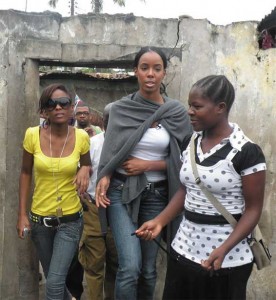

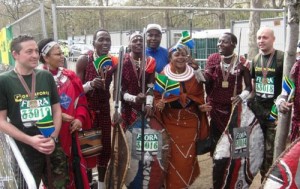
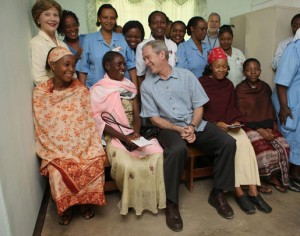 US president Bush at a health centre near Arusha
US president Bush at a health centre near Arusha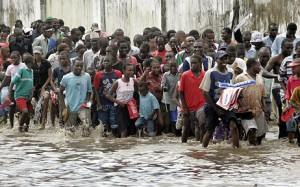 People braving torrential rain to see the Olympic Torch procession pass through Dar-es-Salaam
People braving torrential rain to see the Olympic Torch procession pass through Dar-es-Salaam